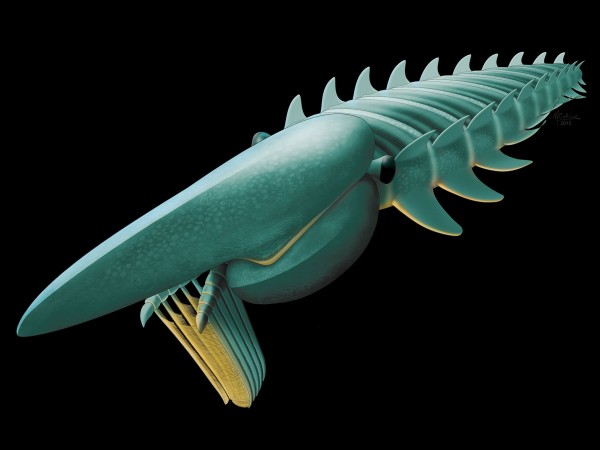Anomalocaris has always been one of my favorite Cambrian animals — it was so weird, and it was also the top predator of the age, making it the equivalent of T. rex. The anomalocarids were also a diverse and successful group, so wouldn’t you know it…it also had a distant filter-feeding cousin in the Ordovician. This is Aegirocassis benmoulae.
Isn’t that beautifully bizarre? The great appendages on the front of the animal have been modified to form a filter-feeding apparatus. It was also a real monster, over 2 meters long.
You want to know more? One of the discoverers, Peter van Roy, has narrated a video in which he explains step-by-step how they reconstructed the organism from the fossils. Very educational!



Why did the cool ones go extinct?
I’m pretty sure that’s how Michael Bey draws whales
“Why did the cool ones go extinct?”
–
Let’s just hope that they’ll be saying that about us in the not too ‘distant’ future…”Stupid but interesting”
Very cool video.
I apparently would need a lot of training to be a fossil hunter, because nearly all those fossils just looked like rocks to me.
I wonder how the “sieve” was cleaned of its plankton food particles. It doesn’t look the filter combs could be inserted into the mouth.
Hopefully no one will try to turn this one into a squid.
This was the second filter feeding anomalocarid discovered. The first was called Tamisiocaris and actually lived during the Cambrian alongside Anomaocaris.
Anomalocaris and Opabinia are my favs. I’d really love to see them alive.
The filter combs may have rotated backwards. They fitted into sockets and may have been controlled by muscles in the forward appendages.
I agree; it’s a very interesting video. This was, functionally, a whale.
Looks like one of the spaceships in “Jupiter Ascending.” Can you stick a European cathedral onto its nose?
Fantastic creature. I was already an Anomalocarid fan, now much more so!
I thought the term was “anomalocaridid” rather than the less-awkward “anomalocarid”?
I like the fins on the body. They remind me of the scutes on a ‘gator’s tail. I don’t see them as slightly-articulated limbs, like the authors seem to, they look like they should be completely rigid to me. I think this thing swam by flexing the body up and down, segmentally. The fins would really help with generating thrust.
The fins are the clearest thing in the fossil, at least that I could see. The shape and sweep of them is very indicative of their function and especially of the speed of swimming. I would want to check other critters for a close estimate of speed, but it looks to me like this thing was not a slowpoke. I guess about 10 miles an hour, cruising constantly.
The head looks streamlined, too. Other than the filters hanging out, this thing could move along.
Hmm, if the filters were retractable, the up-and-down swim motion would make even more sense. Or if they rotated out to make a canard ….
Anyhow, I think the shape of the fins says something that the reconstructors may have missed.
—
Yeah, I also wonder how the plankton got from the filters into the mouth. It could be
something really odd, like digesting the plankton right on the filters – if the filters functioned as gills, it would be halfway there.
Life was different back then, but still the beginnings of what we see now.
And, geeze, the amazingness of being able to figure anything out from looking at fossils like that.
The fins are homologous to the top branch of a biramous arthropod limb. I bet they were flexible, and the animal swam a lot like squid do.
from Wikipedia:
If I understand the video, they are saying that the upper flap and the lower flap together evolved into the biramous leg later on, like this trilobite leg. In that case, I think it’s safe to assume that aegirocassis could move each flap and use them as swimming fins.
David Marjanović beat me to it.
What is wonderful is that filter-feeding anomalocarids (of which this is the second discovered were predicted by speculative zoology
Fuck, man, scientists and understatement.
Also? He mentioned the GOBE! I love GOBE! Not least because there’s so much left to learn about it. Ignorance is fucking fantastic – it’s such an opportunity to delight in learning new things!!!!!
argh, the exact word used by the narrator was “discovery”, not “finding”. Apologies.
Still. You just can’t compete with scientists for understatement.
I mean, how does one begin to compete?
Would these even get me a tryout:
What does a dyke have to do around here to get into the Understatement Premier League?
moarscienceplz and David Marjanović, thank you both.
I can make those fins work as individual moving/sculling things, but that rectangular body section still makes me want it to sweep as a whole. Maybe it started off as a walking sculler, then switched over to sweeping? The fins could ossify?
(I know damn little about biology, obviously. Marine design, that I understand better. (I was looking at an overhead of a whale the other day, and I had no idea the species, but the fins and flukes and body all said it was *fast*.)
And I look at the linked article and it is a little more clear. The fins articulated into limbs.
I need some sleep.
We cultivate that. We say “strongly suggests” when pretty much anyone else would say “proves beyond a shadow of reasonable doubt”…
Imagine a squid. Divide the continuous fin into many little ones. Voilà.